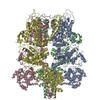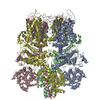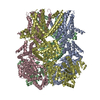+ Open data
Open data
- Basic information
Basic information
| Entry | Database: PDB / ID: 5zx5 | ||||||||||||||||||||||||||||||||||||
|---|---|---|---|---|---|---|---|---|---|---|---|---|---|---|---|---|---|---|---|---|---|---|---|---|---|---|---|---|---|---|---|---|---|---|---|---|---|
| Title | 3.3 angstrom structure of mouse TRPM7 with EDTA | ||||||||||||||||||||||||||||||||||||
 Components Components | Transient receptor potential cation channel subfamily M member 7 | ||||||||||||||||||||||||||||||||||||
 Keywords Keywords | TRANSFERASE / CryoEM / Truncated mouse TRPM7 / MEMBRANE PROTEIN | ||||||||||||||||||||||||||||||||||||
| Function / homology |  Function and homology information Function and homology informationcalcium-dependent cell-matrix adhesion / intracellular magnesium ion homeostasis / magnesium ion transmembrane transport / zinc ion transport / zinc ion transmembrane transporter activity / magnesium ion transmembrane transporter activity / TRP channels / actomyosin structure organization / myosin binding / necroptotic process ...calcium-dependent cell-matrix adhesion / intracellular magnesium ion homeostasis / magnesium ion transmembrane transport / zinc ion transport / zinc ion transmembrane transporter activity / magnesium ion transmembrane transporter activity / TRP channels / actomyosin structure organization / myosin binding / necroptotic process / ruffle / cytoplasmic vesicle membrane / calcium channel activity / kinase activity / calcium ion transport / protein autophosphorylation / actin binding / cytoplasmic vesicle / protein homotetramerization / non-specific serine/threonine protein kinase / protein kinase activity / protein serine kinase activity / protein serine/threonine kinase activity / ATP binding / metal ion binding / nucleus / plasma membrane Similarity search - Function | ||||||||||||||||||||||||||||||||||||
| Biological species |  | ||||||||||||||||||||||||||||||||||||
| Method | ELECTRON MICROSCOPY / single particle reconstruction / cryo EM / Resolution: 3.28 Å | ||||||||||||||||||||||||||||||||||||
 Authors Authors | Zhang, J. / Li, Z. / Duan, J. / Li, J. / Hulse, R.E. / Santa-Cruz, A. / Abiria, S.A. / Krapivinsky, G. / Clapham, D.E. | ||||||||||||||||||||||||||||||||||||
 Citation Citation |  Journal: Proc Natl Acad Sci U S A / Year: 2018 Journal: Proc Natl Acad Sci U S A / Year: 2018Title: Structure of the mammalian TRPM7, a magnesium channel required during embryonic development. Authors: Jingjing Duan / Zongli Li / Jian Li / Raymond E Hulse / Ana Santa-Cruz / William C Valinsky / Sunday A Abiria / Grigory Krapivinsky / Jin Zhang / David E Clapham /   Abstract: The transient receptor potential ion channel subfamily M, member 7 (TRPM7), is a ubiquitously expressed protein that is required for mouse embryonic development. TRPM7 contains both an ion channel ...The transient receptor potential ion channel subfamily M, member 7 (TRPM7), is a ubiquitously expressed protein that is required for mouse embryonic development. TRPM7 contains both an ion channel and an α-kinase. The channel domain comprises a nonselective cation channel with notable permeability to Mg and Zn Here, we report the closed state structures of the mouse TRPM7 channel domain in three different ionic conditions to overall resolutions of 3.3, 3.7, and 4.1 Å. The structures reveal key residues for an ion binding site in the selectivity filter, with proposed partially hydrated Mg ions occupying the center of the conduction pore. In high [Mg], a prominent external disulfide bond is found in the pore helix, which is essential for ion channel function. Our results provide a structural framework for understanding the TRPM1/3/6/7 subfamily and extend the knowledge base upon which to study the diversity and evolution of TRP channels. | ||||||||||||||||||||||||||||||||||||
| History |
|
- Structure visualization
Structure visualization
| Movie |
 Movie viewer Movie viewer |
|---|---|
| Structure viewer | Molecule:  Molmil Molmil Jmol/JSmol Jmol/JSmol |
- Downloads & links
Downloads & links
- Download
Download
| PDBx/mmCIF format |  5zx5.cif.gz 5zx5.cif.gz | 597.4 KB | Display |  PDBx/mmCIF format PDBx/mmCIF format |
|---|---|---|---|---|
| PDB format |  pdb5zx5.ent.gz pdb5zx5.ent.gz | 465.9 KB | Display |  PDB format PDB format |
| PDBx/mmJSON format |  5zx5.json.gz 5zx5.json.gz | Tree view |  PDBx/mmJSON format PDBx/mmJSON format | |
| Others |  Other downloads Other downloads |
-Validation report
| Summary document |  5zx5_validation.pdf.gz 5zx5_validation.pdf.gz | 1.4 MB | Display |  wwPDB validaton report wwPDB validaton report |
|---|---|---|---|---|
| Full document |  5zx5_full_validation.pdf.gz 5zx5_full_validation.pdf.gz | 1.5 MB | Display | |
| Data in XML |  5zx5_validation.xml.gz 5zx5_validation.xml.gz | 94.6 KB | Display | |
| Data in CIF |  5zx5_validation.cif.gz 5zx5_validation.cif.gz | 143.6 KB | Display | |
| Arichive directory |  https://data.pdbj.org/pub/pdb/validation_reports/zx/5zx5 https://data.pdbj.org/pub/pdb/validation_reports/zx/5zx5 ftp://data.pdbj.org/pub/pdb/validation_reports/zx/5zx5 ftp://data.pdbj.org/pub/pdb/validation_reports/zx/5zx5 | HTTPS FTP |
-Related structure data
| Related structure data |  6975MC  7297C  7298C  6bwdC  6bwfC M: map data used to model this data C: citing same article ( |
|---|---|
| Similar structure data |
- Links
Links
- Assembly
Assembly
| Deposited unit | 
|
|---|---|
| 1 |
|
- Components
Components
| #1: Protein | Mass: 141417.719 Da / Num. of mol.: 4 Source method: isolated from a genetically manipulated source Source: (gene. exp.)   References: UniProt: Q923J1, non-specific serine/threonine protein kinase #2: Chemical | ChemComp-Y01 / Has protein modification | N | |
|---|
-Experimental details
-Experiment
| Experiment | Method: ELECTRON MICROSCOPY |
|---|---|
| EM experiment | Aggregation state: PARTICLE / 3D reconstruction method: single particle reconstruction |
- Sample preparation
Sample preparation
| Component | Name: Membrane Protein, Transient Receptor Potential ion channel Type: CELL / Entity ID: #1 / Source: RECOMBINANT |
|---|---|
| Source (natural) | Organism:  |
| Source (recombinant) | Organism:  |
| Buffer solution | pH: 7.5 |
| Specimen | Embedding applied: NO / Shadowing applied: NO / Staining applied: NO / Vitrification applied: YES |
| Vitrification | Instrument: FEI VITROBOT MARK I / Cryogen name: ETHANE |
- Electron microscopy imaging
Electron microscopy imaging
| Experimental equipment |  Model: Tecnai Polara / Image courtesy: FEI Company |
|---|---|
| Microscopy | Model: FEI POLARA 300 |
| Electron gun | Electron source:  FIELD EMISSION GUN / Accelerating voltage: 300 kV / Illumination mode: FLOOD BEAM FIELD EMISSION GUN / Accelerating voltage: 300 kV / Illumination mode: FLOOD BEAM |
| Electron lens | Mode: BRIGHT FIELD |
| Image recording | Electron dose: 56 e/Å2 / Film or detector model: GATAN K2 BASE (4k x 4k) |
- Processing
Processing
| Software | Name: PHENIX / Version: 1.11.1_2575: / Classification: refinement | ||||||||||||||||||||||||
|---|---|---|---|---|---|---|---|---|---|---|---|---|---|---|---|---|---|---|---|---|---|---|---|---|---|
| EM software | Name: PHENIX / Category: model refinement | ||||||||||||||||||||||||
| Image processing | Details: TRPM7 image stacks were recorded on Gatan K2 Summit (Gatan) direct detector set in super-resolution counting mode using SerialEM | ||||||||||||||||||||||||
| CTF correction | Type: PHASE FLIPPING AND AMPLITUDE CORRECTION | ||||||||||||||||||||||||
| Particle selection | Num. of particles selected: 2068004 Details: Particle picking and subsequent bad particle elimination through 2D classification was performed using Python scripts/programs developed by Maofu Liao (Ru et al., 2015) with minor ...Details: Particle picking and subsequent bad particle elimination through 2D classification was performed using Python scripts/programs developed by Maofu Liao (Ru et al., 2015) with minor modifications in the 8x binned images. | ||||||||||||||||||||||||
| Symmetry | Point symmetry: C4 (4 fold cyclic) | ||||||||||||||||||||||||
| 3D reconstruction | Resolution: 3.28 Å / Resolution method: FSC 0.143 CUT-OFF / Num. of particles: 1039775 / Symmetry type: POINT | ||||||||||||||||||||||||
| Refine LS restraints |
|
 Movie
Movie Controller
Controller







 PDBj
PDBj

